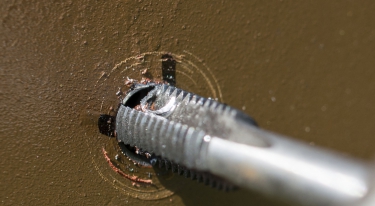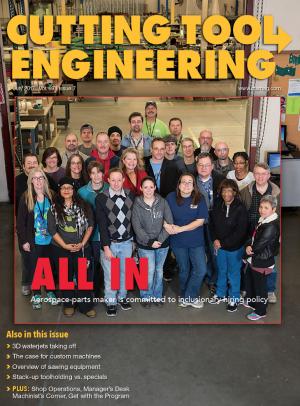YouTube videos to the contrary, it’s probably not a good idea to sharpen dull taps by hand, especially using a Dremel tool or bench grinder. A high-quality tool and cutter grinder might do the trick. However, these are limited to touching up the chamfers and possibly the flute faces.
A grinder designed for grinding the actual tap form is required for more thorough reconditioning. Regardless, why spend time sharpening taps (or any other cutting tool) when you could be making parts? This is one job best left to the experts.
Those experts include Tap Saver LLC, Commerce Township, Mich.; Tapco Cutting Tools Inc., Loves Park, Ill.; and Cheboygan (Mich.) Tap & Tool Co. They promise to quickly return worn taps to like-new condition. They also can modify taps to improve threading performance.

Properly resharpened taps often perform as well as new, at a fraction of the cost.
When reconditioning taps, the first consideration is tap size. Taps that are 1⁄4-20 and smaller cost less than a double latte at Starbucks. Most industry experts will tell you it’s best to recycle them at the first sign of flank wear.
“At Cheboygan Tap & Tool, we take our resharpening program very seriously,” said Engineering Manager Jeff McLeod. “We have long-standing relationships with customers who understand the benefits of pulling a tool before its usable life and taking advantage of our services. This is especially true with complex, multiple-start tooling, (ball form, ACME) that require long lead times to manufacture, whereas a resharpening/reconditioning program can keep the customer making parts.”
The other consideration is process control. While like-new condition is just fine when detailing a car, it might be less than adequate when making a batch of expensive aerospace or medical parts. Still, for shops where every penny counts or those machining high-volume, commodity-grade products, resharpened taps might bring big benefits.
Consider sending some worn taps to a regrinder as a test. If the documented results are positive, work with your production team to implement a reconditioning program, and be sure to keep refurbished taps separate from new ones.
Jackie Brewster, president and co-owner of Tapco, said “like new” is a misnomer. “It’s more accurate to say ‘resharpened to a functional tool,’ ” she said. “Regardless, the biggest benefit of tap resharpening is found with special taps. Standard tools are not as cost-effective, although they are still a good value for many shops. We simply look at a tool and determine if it is at all salvageable and worth the cost of sharpening. The end user must be the one to determine if doing so is worthwhile.”
One thing to keep in mind about reground taps is that they lose one H size (0.0005", or 12.7µm) or more during resharpening. However, less material is lost as tap size decreases. So, a reconditioned tap may not perform as it did prior to regrinding. That could lead to reworking or scrapping a part.
Contact Details
Related Glossary Terms
- flank wear
flank wear
Reduction in clearance on the tool’s flank caused by contact with the workpiece. Ultimately causes tool failure.
- grinding
grinding
Machining operation in which material is removed from the workpiece by a powered abrasive wheel, stone, belt, paste, sheet, compound, slurry, etc. Takes various forms: surface grinding (creates flat and/or squared surfaces); cylindrical grinding (for external cylindrical and tapered shapes, fillets, undercuts, etc.); centerless grinding; chamfering; thread and form grinding; tool and cutter grinding; offhand grinding; lapping and polishing (grinding with extremely fine grits to create ultrasmooth surfaces); honing; and disc grinding.
- process control
process control
Method of monitoring a process. Relates to electronic hardware and instrumentation used in automated process control. See in-process gaging, inspection; SPC, statistical process control.
- tap
tap
Cylindrical tool that cuts internal threads and has flutes to remove chips and carry tapping fluid to the point of cut. Normally used on a drill press or tapping machine but also may be operated manually. See tapping.
- threading
threading
Process of both external (e.g., thread milling) and internal (e.g., tapping, thread milling) cutting, turning and rolling of threads into particular material. Standardized specifications are available to determine the desired results of the threading process. Numerous thread-series designations are written for specific applications. Threading often is performed on a lathe. Specifications such as thread height are critical in determining the strength of the threads. The material used is taken into consideration in determining the expected results of any particular application for that threaded piece. In external threading, a calculated depth is required as well as a particular angle to the cut. To perform internal threading, the exact diameter to bore the hole is critical before threading. The threads are distinguished from one another by the amount of tolerance and/or allowance that is specified. See turning.


